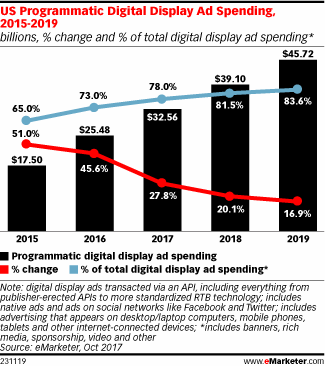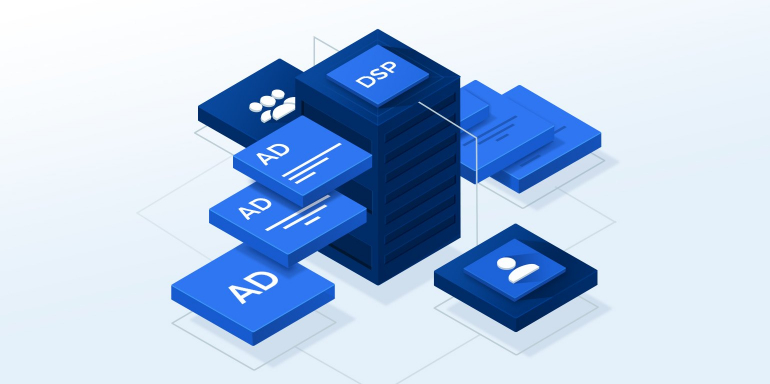Ad buying and selling didn’t used to be as easy as it is today. Manual insertion orders, sit-down meetings, contracts were all once part of the drawn-out process of publishing of an ad. In the past, it could take days or weeks. Now, with the help of demand-side platforms and supply-side platforms, it’s an efficient and near-instantaneous process.
What is a demand-side platform (DSP)?
A demand-side platform is software used by advertisers to buy mobile, search, and video ads from a marketplace on which publishers list advertising inventory. These platforms allow for the management of advertising across many real-time bidding networks, as opposed to just one, like Google Ads. Together with supply-side platforms, DSPs enable programmatic advertising.
What is programmatic advertising?
Programmatic advertising is the process of buying and selling ads with software and publishing those ads contextually based on complex algorithms. Most online advertising now is done programmatically through real-time bidding and direct deals.
- Real-time bidding: advertising like this takes place in real-time. You specify who you want to reach with your ads, how much you’re willing to spend, then, a bidding war takes place between you and all the other advertisers trying to reach the same audience. A prospect lands on a page, and before the page loads fully, algorithms determine which ad to display to them. These algorithms take things like browsing history, time of day, IP address into account. Whoever has bid highest for the impression when all’s collected wins the placement.

- Programmatic direct: this kind of advertising is more like the traditional model moved to the internet. It’s ideal for businesses that want guaranteed ad placements in premium locations. Homepages of big-name publishers, for example, will often sell their ad space via programmatic direct deals. The publisher provides the advertiser with details about its visitors. If those visitors are the advertiser’s ideal audience, then the advertiser can choose to reserve a portion of publishing space for an upcoming campaign.

According to eMarketer, programmatic advertising has been steadily growing in popularity. By 2019, it’s expected that 83.6% of display advertising will be bought and sold programmatically:

Programmatic isn’t just display advertising, though. It refers to ad sales on search networks too, and any other network bought with software. However, when you buy ads through these networks (like Google Ads for example) individually, you’re not necessarily using a demand-side platform.
How a DSP works
Demand-side platforms are independent of individual networks. If you’re managing ads through Google Display Network manager, you’re buying impressions on Google publishers only. If you’re using the Facebook Ads Manager to buy ads, you’re buying impressions on Facebook or Instagram specifically. Demand-side platforms are independent of these networks. They are third-party software that allow you to purchase, analyze, manage ads across many networks from a single place.
In the programmatic advertising picture, demand-side platforms give advertisers all the information they need to buy advertising from a publisher. They don’t own or purchase media directly from publishers, but instead communicate with a supply-side platform through an ad exchange.
Supply-side platforms allow publishers to list that inventory on the ad exchange, and they communicate with DSPs about the details of an impression.
If that impression is a marketing manager who has visited your demo post-click landing page before, she’s more valuable to you than somebody who’s never visited your website before. In that case, your DSP will likely bid higher for the impression. Whether you win the bid will depend on how valuable this impression is to other businesses. Maybe she’s abandoned her cart on an ecommerce website. If that’s the case, the ecommerce website may bid more to serve an ad that gets her to the checkout page. It all depends on the budget of the bidder and the value of the impression. This is all facilitated automatically by the SSP, DSP and the ad exchange between advertisers and publishers.
Why use a demand-side platform?
Using a demand-side platform has its advantages and disadvantages. It’s good to know a few before you invest heavily in a software.
Pros of using a DSP
-
- Efficiency: If you’re managing campaigns across many networks, a DSP makes sense to use. This way, everything is adjustable from one dashboard.
-
- Data: Many DSPs partner with third-party data providers to offer advertisers as much information as possible. Often it’s more than a single network can provide. Additionally, many DSPs allow customers to import their own data from a CRM or a DMP (data management platform).
-
- Targeting: With more data comes pinpoint targeting capabilities. Better targeting means more personalized ads and post-click landing pages, which means a higher likelihood of conversion.
-
- Support: Demand-side platforms will often provide support beyond the traditional helpdesk-style customer support of a single network.
- High-quality inventory: DSPs will have access to the major networks and then some. If you’re after more premium inventory, a demand-side platform may be what you’re looking for. Some may have more access than others, though, so it’s important to find out before you pick one.
Cons of using a DSP
-
- Cost: DSPs can require significant investment, and if you’re not budgeting more than $5,000 per month for ad spend, says Kevin Lee, you can probably get all the reach you need from the Google Display Network.
- Complexity: Whenever you aggregate data, you run the risk of overcomplicating things. Some advertisers may find demand-side platforms too complex to learn quickly enough to see a benefit.
Assemble your million-dollar marketing stack
For some businesses, a demand-side platform will make the most sense. It offers efficiency and a broader reach of prospects across multiple ad exchanges, including more premium inventory. For those advertising on a select few platforms, though, the cost and complexity of a DSP may not be worth working into your advertising tool stack.
For more on tools to power your million-dollar advertising spend, get the new Instapage guide: The Advertising Stack to Power Your $1 Million Ad Spend.

See the Instapage Enterprise Plan in Action.
Demo includes AdMap™, Personalization, AMP,
Global Blocks, heatmaps & more.
